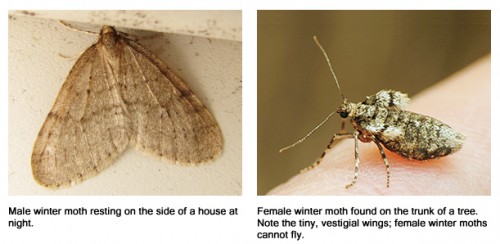2015 Winter Moth Fall Tree Wrapping
 Winter moth is an invasive pest introduced into North America from Europe. With no natural enemies, the population is exploding. These caterpillars devastated Rhode Island trees this spring. The adult winter moths come out from late November through December. In late fall across Rhode Island you may see small, dull gray moths attracted to porch lights in large numbers, especially on warm evenings. On some roads, you’ll see clouds of moths in headlights. These are all male moths. The females have tiny wings and cannot fly. Females emerge from the ground and scramble up nearby tree trunks where they will mate and lay eggs. When the caterpillars hatch in spring, they wriggle into swelling buds and begin feeding.
Winter moth is an invasive pest introduced into North America from Europe. With no natural enemies, the population is exploding. These caterpillars devastated Rhode Island trees this spring. The adult winter moths come out from late November through December. In late fall across Rhode Island you may see small, dull gray moths attracted to porch lights in large numbers, especially on warm evenings. On some roads, you’ll see clouds of moths in headlights. These are all male moths. The females have tiny wings and cannot fly. Females emerge from the ground and scramble up nearby tree trunks where they will mate and lay eggs. When the caterpillars hatch in spring, they wriggle into swelling buds and begin feeding.
Trying to control male moths is useless; pesticide sprays will be a wasted effort and could harm other insects. It may be helpful to trap female moths with tree barriers to stop them as they climb up trees. At this time it is unknown how effective tree banding can be. It will depend on many things including how many trees are in an area and the size of the winter moth population. Tree banding will probably be most successful in yards with very few trees, no woods nearby and a moderate winter moth population.
 Tree bands should be in place by mid-November. Tree bands can be homemade or purchased from a garden center. Commercial products include BugBarrier and Tree Wrap. BugBarrier can be purchased from Tree Shelter in Attleboro Falls, MA. Homemade bands can be made by spreading a sticky substance, such as Tree Tanglefoot to duct tape or plastic wrap attached to tree trunks. Don’t coat tree trunks directly with Tanglefoot or any sticky substance.
Tree bands should be in place by mid-November. Tree bands can be homemade or purchased from a garden center. Commercial products include BugBarrier and Tree Wrap. BugBarrier can be purchased from Tree Shelter in Attleboro Falls, MA. Homemade bands can be made by spreading a sticky substance, such as Tree Tanglefoot to duct tape or plastic wrap attached to tree trunks. Don’t coat tree trunks directly with Tanglefoot or any sticky substance.
Where there is a large population of winter moths, dead moths can completely cover the sticky surface and then female moths can easily walk over dead moths. It may be useful to have two tree bands per tree so you can monitor if female moths are climbing past the first barrier. If this happens, replace the failed barrier.
When a female moth encounters a tree band she tends to lay many eggs right below the tree band. For this reason, tree-banded tree trunks should be sprayed with a dormant oil next March to kill eggs laid on the trunk.
Heather Faubert will demonstrate setting up BugBarrier on October 27, 2015 at 3 p.m. at URI’s East Farm, 2150 Kingstown Rd., Kingston. East Farm is on Route 108, about 1/2 mile south of the Route 138/Route 108 intersection. A limited amount of BugBarrier will be available for participants. Please email Heather at hhf@uri.edu if you plan to attend. RAIN OR SHINE!
